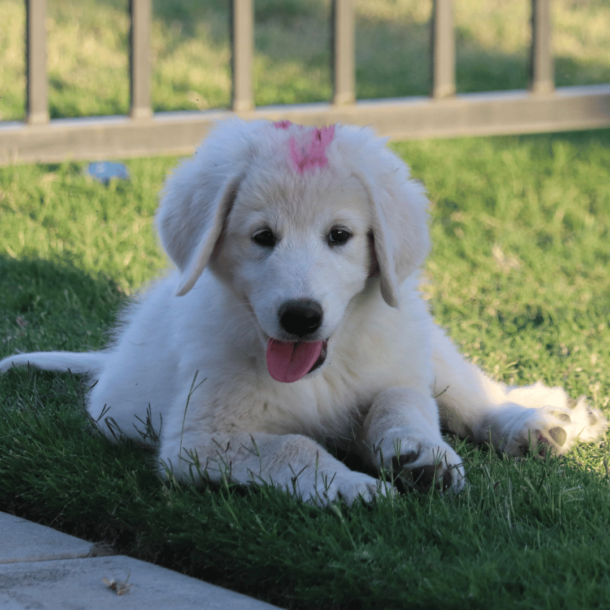Last Updated on October 24, 2025 by Kim Crawmer, KPA CTP, LFDM
Most breeders focus on genetics. We’ve engineered an entire system that turns great genetics into exceptional livestock guardian dogs.
When livestock owners ask me what makes Prancing Pony Farm puppies different, they expect me to talk about bloodlines, health testing, or training techniques. While those matter enormously, the real secret lies in something most people never consider: the environment where puppies spend their most critical developmental weeks.
After years of raising livestock guardian dogs and learning from both successes and challenges, I realized that where puppies grow up matters as much as who their parents are.
That realization led to the creation of our Puppy Parlor system—a carefully designed environment that doesn’t just house puppies, but actively develops them into confident, livestock-bonded guardians.
📚 LGD Puppy Development Series:
- Part 1: The Critical Window: Why early socialization makes or breaks your LGD
- Part 2: From Helpless to Hero: the Remarkable Journey of LGD Development
- Part 3: The Puppy Parlor Method: How We Raise and Socialize LGD Puppies
- Part 4: Puppy Socialization for LGDs: Why Human Interaction Builds Better LGDs
- Part 5: Livestock Integration for LGD Puppies: From Observation to Interaction
- Part 6: Building Immunity: The LGD Health Protocols That Protect Your Investment
- Part 7: Child Socialization for LGDs: Why it's Crucial for Family Farms
- Part 8: LGD Socialization: Meet Genny, the Maremma Mentor Who Perfects Every Puppy's Education
- Part 9: Beyond the Puppy Parlor: What Your LGD Needs Next
The Problem with Most Livestock Guardian Dog Breeding
The hard truth about livestock guardian dog breeding is that most breeders aren’t actually raising working LGDs at all.
The majority of Maremma breeders, especially, are raising what amounts to expensive pets in their houses, garages, patios, or backyards. Some of their dogs may have impressive pedigrees and beautiful conformation (and some don’t), but they’ve never lived with livestock, never learned to guard, and never developed the deep species bonds that make effective guardians.
These puppies might get occasional “visits” to a barn for photo opportunities, but no real daily integration with stock. When buyers receive these dogs and expect them to immediately bond with and protect livestock, disappointment and failure are almost inevitable.
On some farms the adult dogs patrol around a large property with livestock contained within their own fenced area, seperate from the dogs. This is not the same as a dog living with stock. If you see this kind of setup when visiting a breeder you should take it as a big red flag. It could mean that the breeder doesn’t know how to socialize LGDs with stock, doesn’t understand the importance, or, worst of all, that their dogs can’t be trusted with livestock. You do not want to buy a puppy from such a breeder.
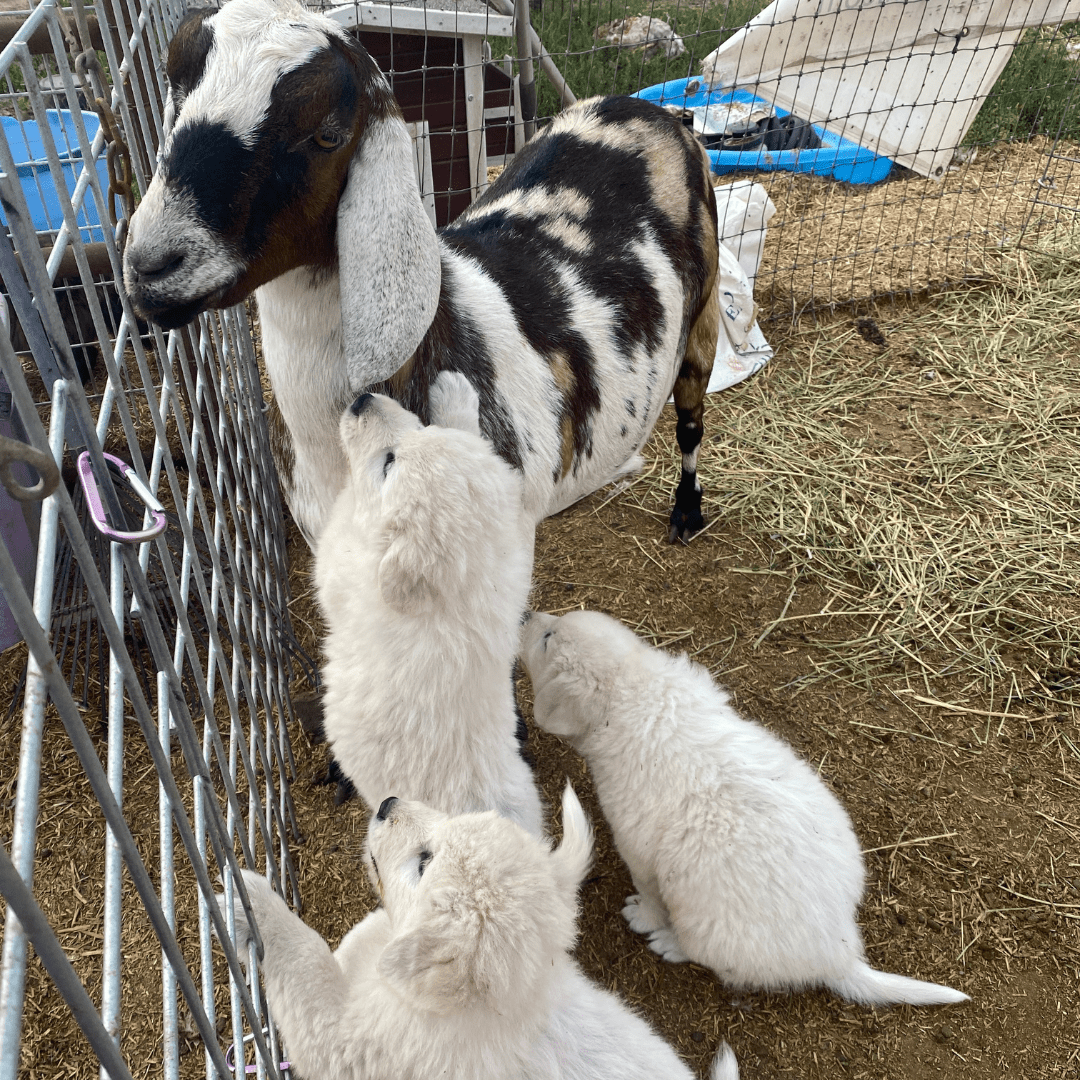
Human Socialization is Vital for any LGD Program
Even among the few breeders who do raise puppies with livestock, many neglect human socialization entirely. This creates a different but equally serious problem: fearful, shy, or aggressive dogs that can’t be safely handled for veterinary care or daily management. These dogs may be a liability because of the potentail for biting a family member or visitor.
Livestock guardian dogs need BOTH types of socialization—livestock integration AND comprehensive human/environmental exposure. Skipping either component creates problems that last a lifetime.
At Prancing Pony Farm, every puppy receives complete socialization regardless of whether they’re destined for working homes or companion families. I raise working livestock guardian dogs, some of whom become beloved pets. I don’t raise pets and call them working dogs.
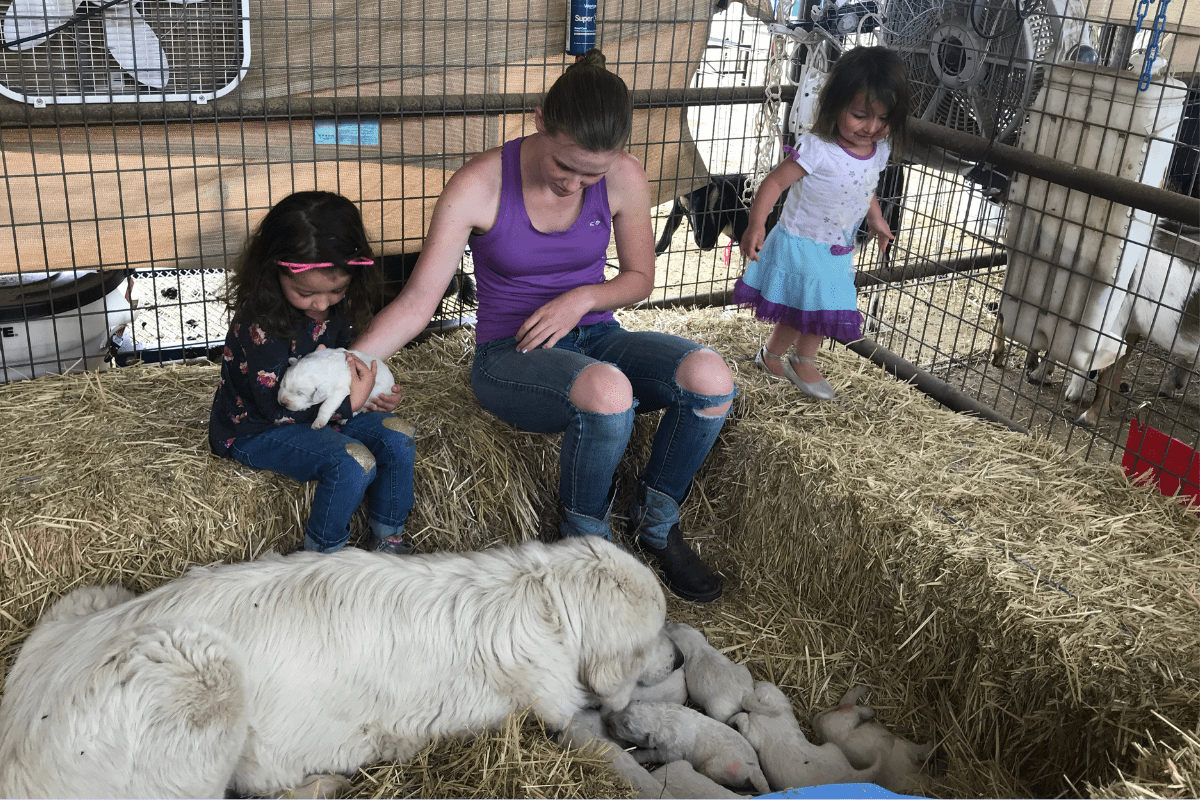
My Journey: From Barn Breeding to the Puppy Parlor System
I’ve never raised a litter away from livestock. Never. From my very first litter, my puppies have been surrounded by the sights, sounds, and smells of farm animals from birth.
The Early Years: Learning Through Trial and Dedication
For my first 11 litters, I raised puppies directly in my dairy goat barn, surrounded by goats, chickens, barn cats, and other farm animals. The livestock socialization was fantastic. Puppies could see, smell, and hear goats, chickens and other animals from birth, creating the deep bonds that make exceptional livestock guardians.
But it wasn’t easy. I had to rebuild my whelping area for every litter, often trying to fit puppies into an already crowded kidding barn, while preventing newborn puppies from being stepped on by the goats in the early weeks. One year I even had baby goats and puppies sharing the same stall! The dedication required was enormous, but the socialization results were worth it.
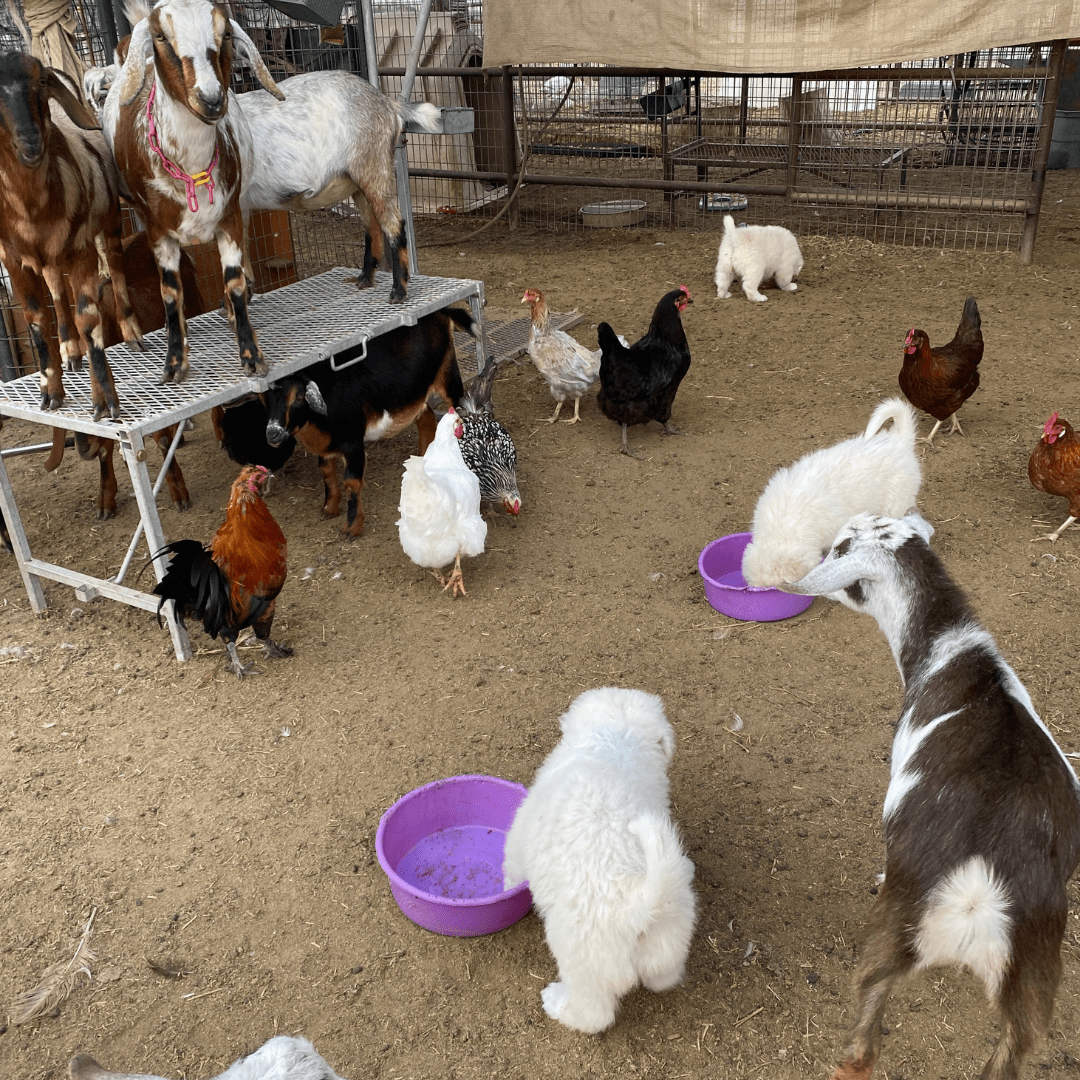
When Challenges Became Crises
As my breeding program grew beyond one or two litters per year, serious problems emerged that I couldn’t ignore:
Weather Extremes: Dogs come into heat regardless of weather, making it impossible to plan ideal conditions. I had puppies born in January (extremely cold) and August (over 100 degrees). Climate control in a barn is impossible in a California-style barn. (My barn is only a roof with no solid walls. The walls are welded wire horse panels. Try keeping out the cold, rain or sun in that!)
Environmental Disasters: The year of our August and September 2020 litters, California forest fires created dangerously unhealthy air conditions. The smoke caused health problems in some puppies and created a crisis situation I couldn’t manage safely in an open barn environment.
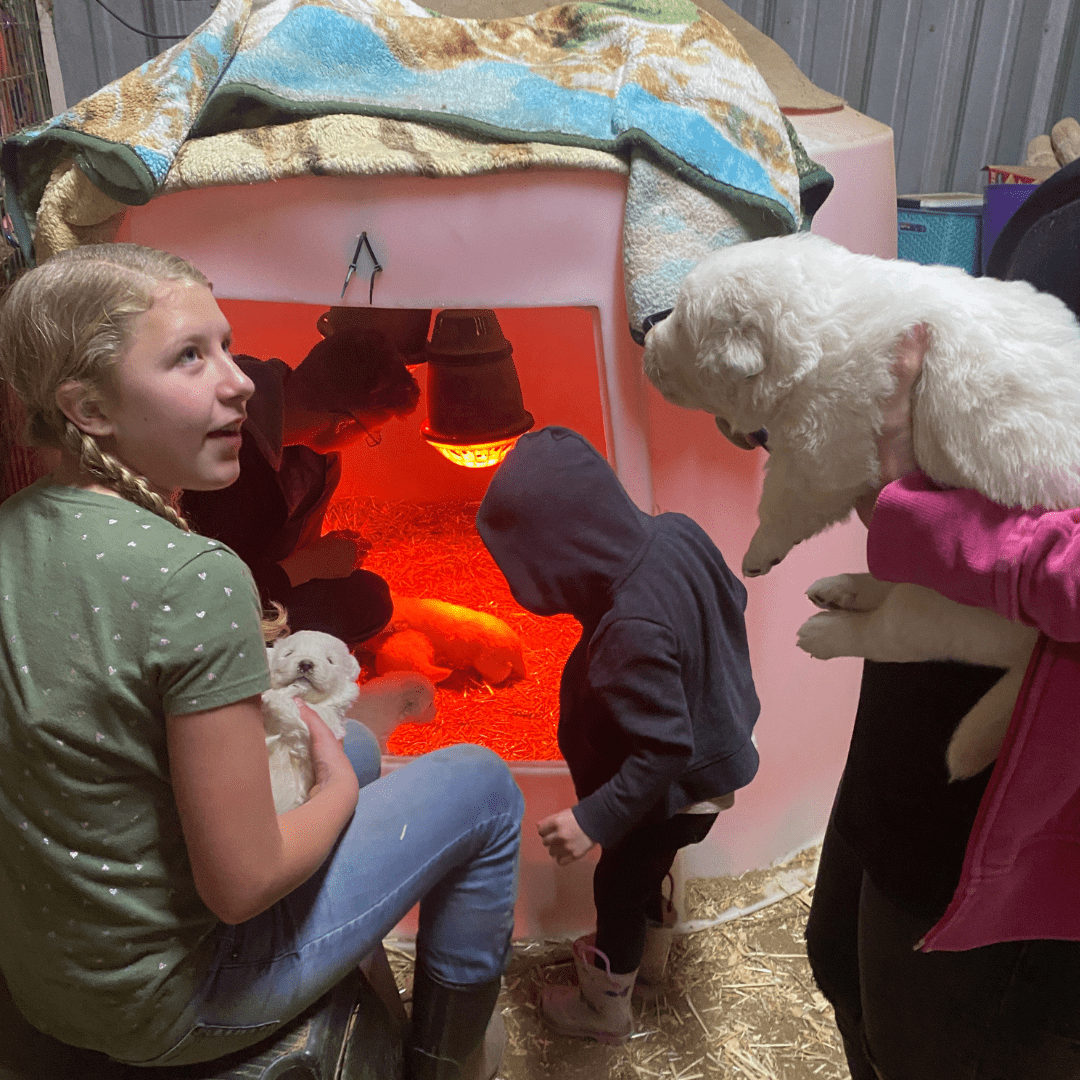
Desperate Measures: I tried using my enclosed milking parlor trailer for winter and summer litters, but it created new problems. I had to move all my milking equipment out in order to fit the whelping box in the space, and there was no easy way for mothers to go outside. One stressed mother even jumped through the glass window (several feet off the ground) trying to get out to potty. When the AC in the trailer broke during that smoke-filled August, I had to move the puppies back to the barn with heat and dangerous air quality.
The Heartbreak: That litter suffered mysterious illnesses, chronic sinus infections, and I lost a puppy—undoubtedly from the smoke exposure.
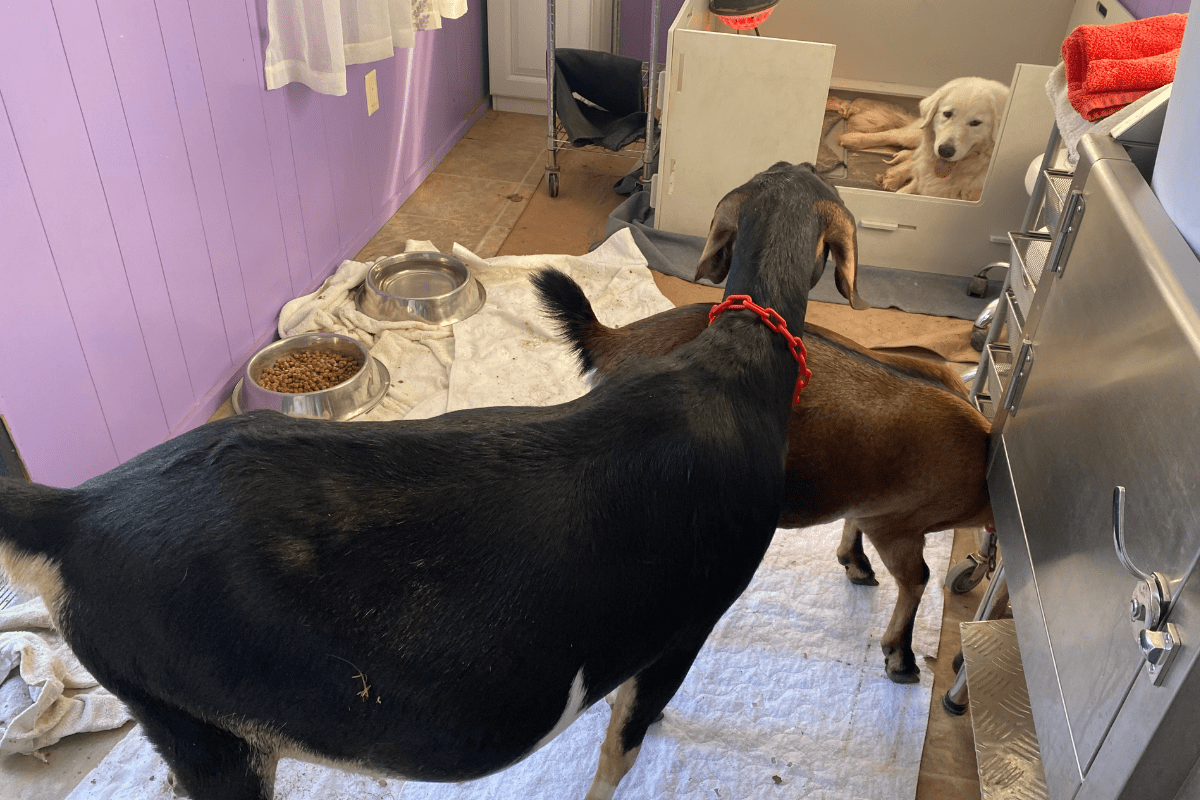
The Parasite Crisis That Changed Everything
Around the same time, parasite problems escalated beyond anything I’d experienced. What we initially thought was parvo turned out to be severe giardia and coccidiosis. I spent several thousand dollars treating one litter, thinking I had it under control.
The next year brought even worse devastation: I lost three puppies between 7-8 weeks to parasites.
I sat in that barn and cried. I promised the mother of those puppies that I would do better.
It wasn’t from lack of trying—I was treating puppies for parasites for five days in a row every two weeks with very expensive medications. (One for Giardia and a different medication for coccidiosis.) But raising puppies in an outdoor environment with dirt floors, livestock, and standing water (troughs, puddles) was an uphill battle. Mothers would track parasite eggs back to their puppies. The dirt absorbed any evidence of illness in puppies. More than once, I left the barn with seemingly healthy puppies only to find one deathly ill the next morning.
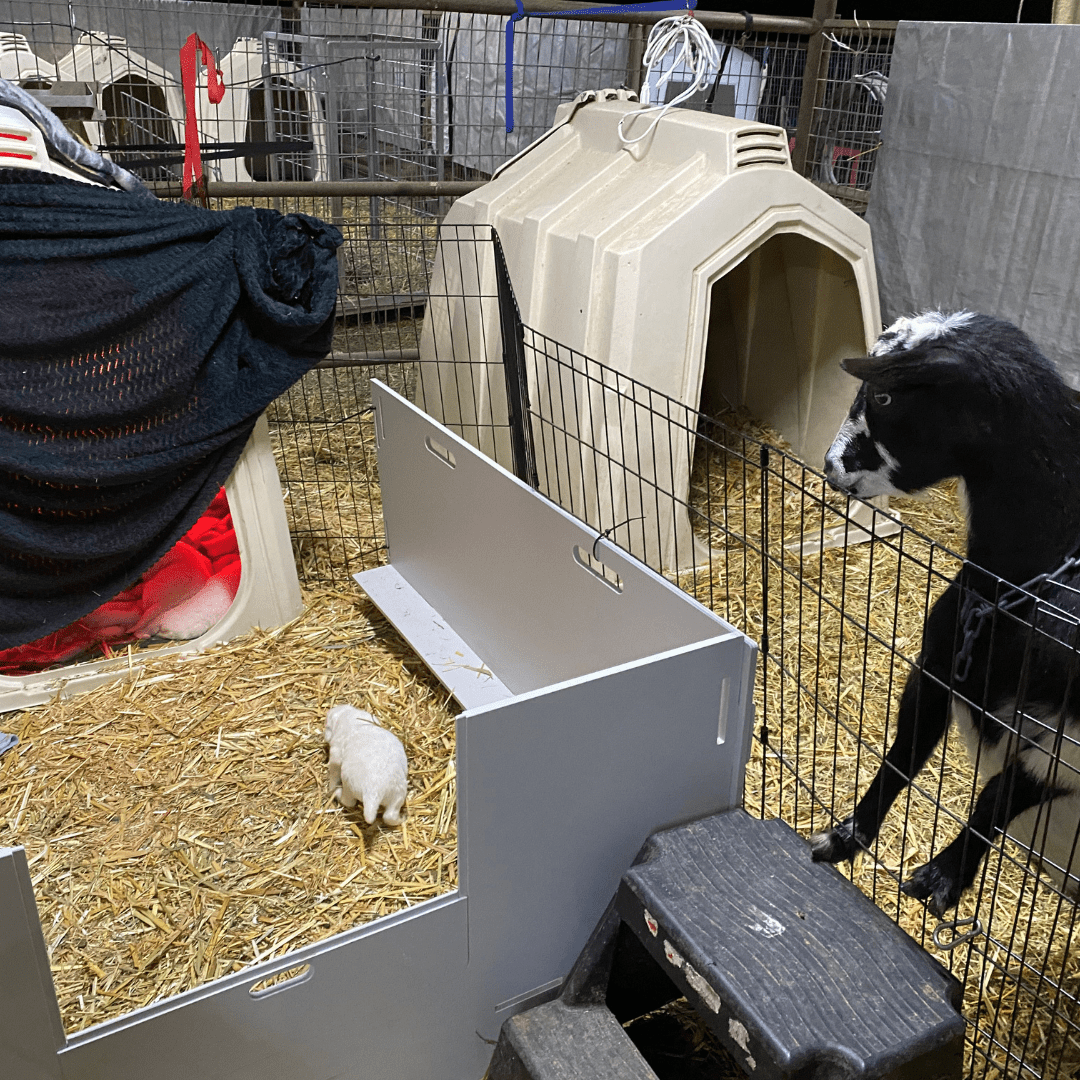
The Solution: Engineering Success
After that heartbreaking experience, I knew I needed a solution that would keep my puppies healthy, temperature-controlled, and safe while never compromising on livestock socialization.
That’s when I decided to build the Puppy Parlor.
It was a long, expensive process, but the Puppy Parlor became the best investment I’ve ever made in my business, farm, and breeding program.
This isn’t just a fancy puppy facility—it’s the center hub of my entire operation, serving as:
- Puppy development center with optimal environment control
- Milking parlor for my dairy goats
- Grooming facility for dogs and goats
- Hospital ward for any farm animal needing care
- Meet-and-greet area for visitors and buyers
- My happy place where everything important happens
Most importantly, it solved every problem I’d faced while enhancing the livestock socialization that had always been my strength.
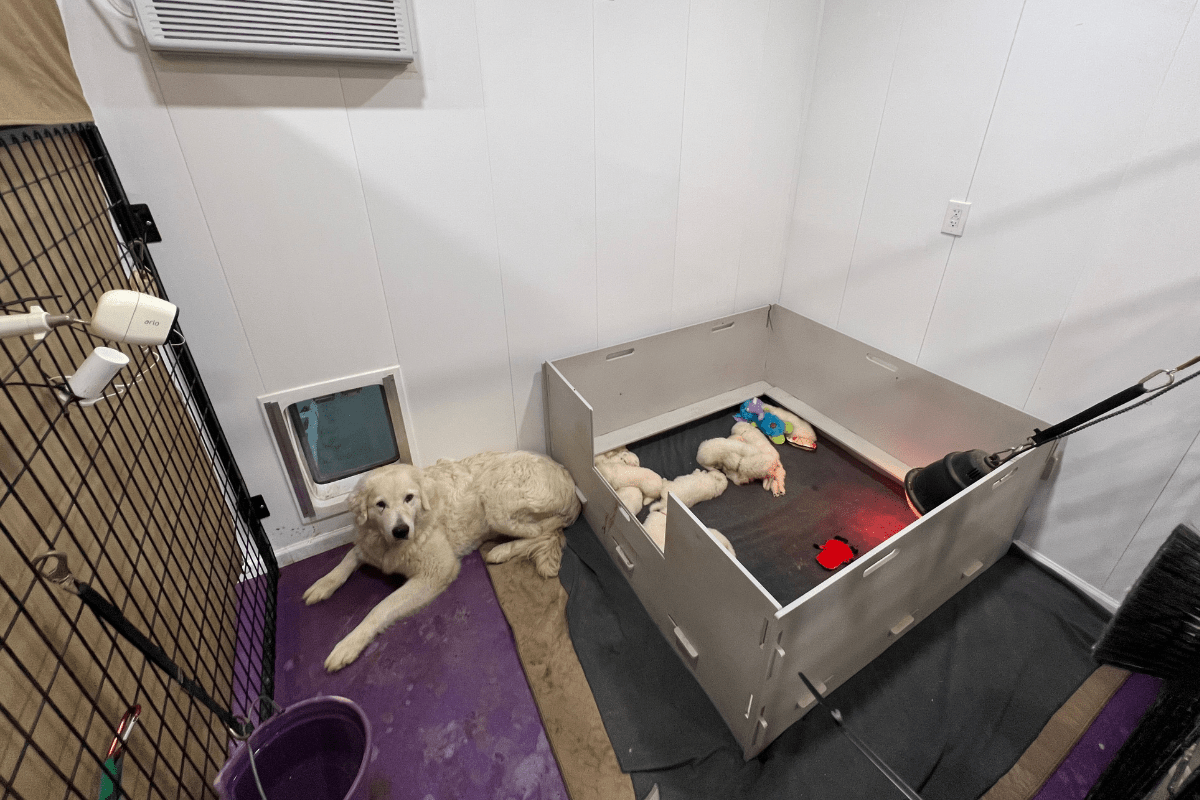
Week 3: The Magic Begins
At exactly 3 weeks old—when puppies’ eyes and ears have fully opened, they’re climbing out of the whelping box and walking confidently—the real magic of the Puppy Parlor system begins.
This week marks several crucial milestones:
First Visual Livestock Contact
With their improved vision, puppies get their first clear look at the gentle goats who will become their teachers. This isn’t accidental exposure—it’s carefully orchestrated first impressions.
We use specific “trainer” goats chosen for their calm temperaments and positive interactions with young animals. These experienced does understand their role and seem to enjoy meeting each new litter.
What we’re watching for in puppies:
- Curiosity without fear
- Calm observation behaviors
- Natural interest in livestock movement and sounds
- Positive body language during visual contact
What we look for in puppy trainer goats.
- Gentle behavior with puppies (no bullies allowed)
- They genuinely enjoy being around dogs
- They are calm and quiet and not skittish or flighty (which can frighten young puppies or provoke chase behavior in older pups)
- They know how to avoid stepping on small puppies
- They will respect the puppies’ mom if she tells them to give the puppies space
I have certain goats in my herd who meet all these criteria and a few who really love dogs. These goats get permanent status as puppy trainers and will nevr be sold. They are worth their weight in gold.
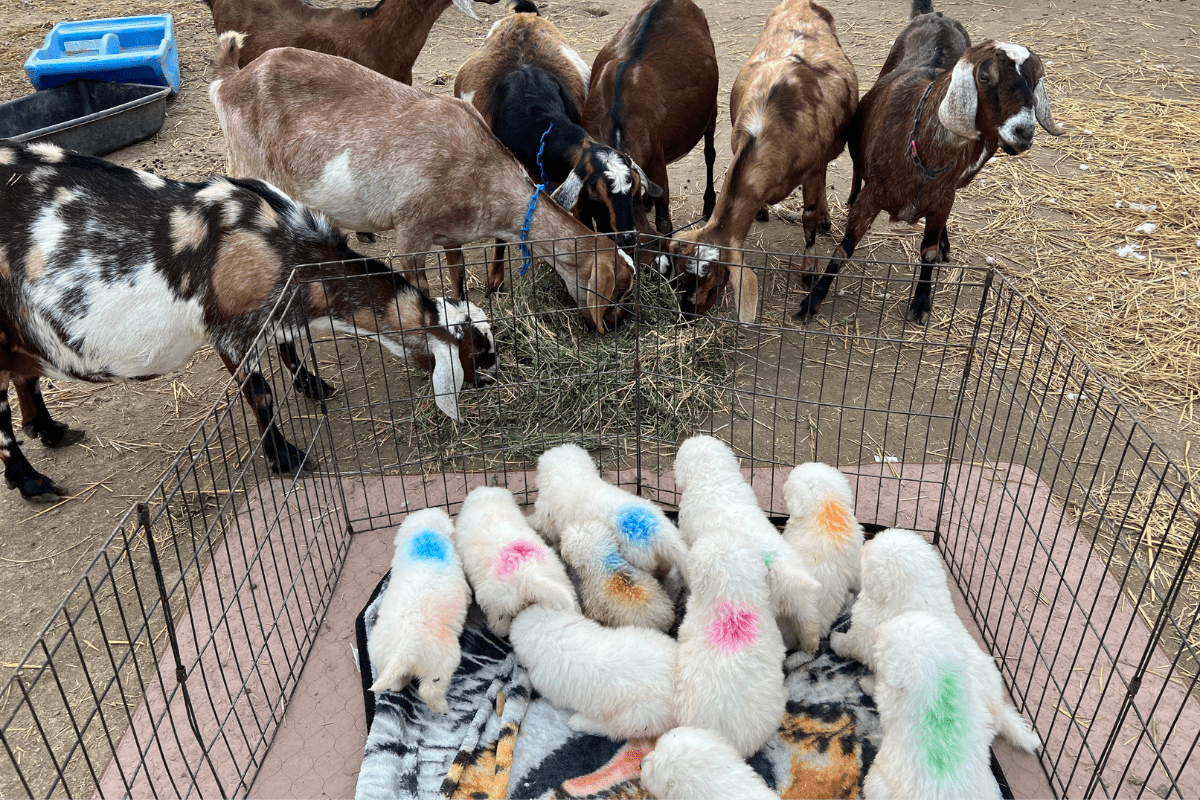
Nutritional Transition with Health Benefits
Week 3 also marks the beginning of supplemental feeding with our specially formulated puppy mush. But this isn’t just about nutrition—it’s another layer of our integrated health system.
Our puppy mush includes Cocci Guard, a coccidiosis preventive for goats and sheep, sold by Revival Animal Health. We mix it into the puppy mush and also feed it to our pregant and nursing moms. This product has eliminated the need for the aggressive (and expensive and time consuming) medication protocols we used to require. Since implementing this system, we haven’t had a single case of coccidiosis in our puppies.
This is preventing parasites before they start, not just treating the symptoms afterwards.
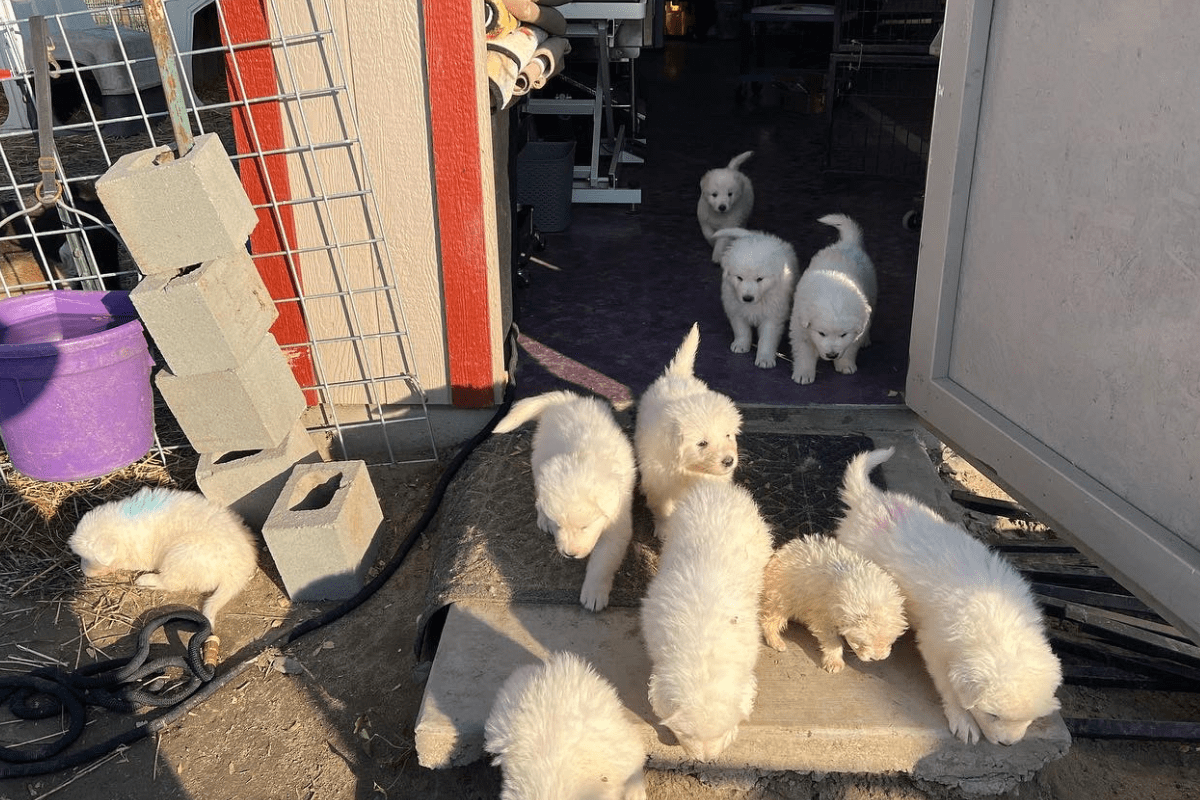
Environmental Health Revolution
Here’s where the Puppy Parlor system really shines: since building this specialized environment, our parasite issues have virtually disappeared.
In our old barn setup, puppies routinely needed aggressive deworming protocols starting at 2 weeks (for five days in a row each time) and continuing every 2 weeks. (And a seperate protocol for coccidiosis prevention, on the same 2 week schedule. It seemed like all we did was medicatew puppies and it wasn’t enough.) The Puppy Parlor’s design (concrete floors and drains) have eliminated most parasite pressure, allowing us to use much gentler protocols.
Current protocol:
- First gentle deworming at 3 weeks (if needed but often it can be skipped)
- Cocci Guard prevention in food
- Giardia prevention starting at 6 weeks
- Far less medication, much healthier puppies

Structured Enrichment Program
Every day brings new experiences designed to build confidence and environmental adaptability:
Week 3 Enrichment Examples:
- Different textural surfaces (rubber mats, blankets, artificial grass)
- Novel objects rotated daily (safe toys, household items, farm tools)
- Varied sound experiences (music, television, farm equipment, thunderstorm sounds, different livestock sounds – real and recorded. There’s a Fire TV in the Puppy Parlor that I use to play all these sounds and I also have a speaker inside that will amplify the sounds from outside.)
- Gentle human handling exercises
- First supervised ground-level livestock interactions

The Science Behind the Success
This isn’t just a nicer puppy setup—it’s applied developmental science.
Research shows that puppies who experience rich, varied environments during weeks 3-12 develop:
- Better stress resilience throughout life
- Improved learning capacity
- Stronger immune systems
- More confident exploration behaviors
- Better social integration skills
Our Puppy Parlor system delivers all of these benefits while specifically optimizing for livestock guardian development.

Why Environment Matters More Than You Think
Consider these two scenarios:
Scenario A: Puppy raised in a kennel, house, garge or backyard, brought to see livestock occasionally, dewormed aggressively every 2 weeks, limited environmental variety.
Scenario B: Puppy raised in enriched environment with daily livestock contact, more natural health prevention, constant novel experiences, and a carefully planned and implemented socialization program.
Both puppies might have identical genetics, but their capabilities will be dramatically different.
Scenario A produces a dog that can learn to guard livestock with extensive training. Scenario B produces a dog that naturally understands livestock as family and adapts confidently to new challenges.

The Prancing Pony Farm Difference
Our Puppy Parlor system isn’t just about luxury—it’s about engineering success:
Health Benefits:
- 90% reduction in parasite issues
- Stronger immune systems from controlled exposure
- Less medication stress on developing systems
- Natural prevention approach
- More comfortable and healthy moms and puppies
Behavioral Benefits:
- Livestock bonding starts at 3 weeks instead of 8+ weeks
- Daily confidence building through novel experiences
- Stress resilience from graduated challenges
- Natural environmental adaptability
Long-term Benefits:
- Easier transitions to new homes
- Faster integration with new livestock
- More reliable guarding behaviors
- Better human-dog relationships
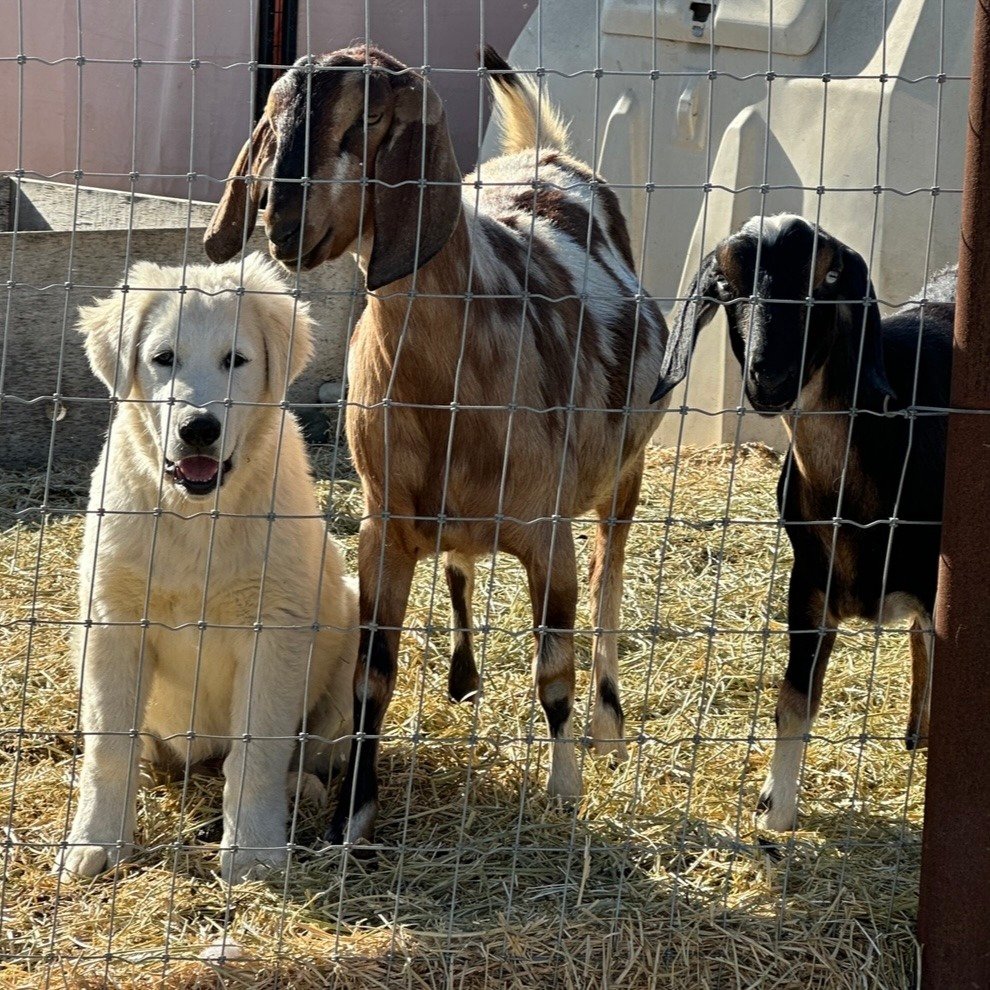
What This Means for Your Investment
When you choose a Prancing Pony Farm Maremma Sheepdog puppy, you’re not just getting great genetics—you’re getting the result of an entire system designed to maximize your livestock guardian dog’s potential.
Every aspect of our environment is intentionally designed to create the confident, healthy, livestock-bonded guardian you need.
Questions to ask other breeders:
- Where exactly do puppies spend their first 12 weeks?
- What specific livestock integration protocols do you use?
- How do you prevent parasite issues rather than just treat them?
- What environmental enrichment programs do you provide?
- Can you show me your puppy development facility?
Red flags:
- Puppies raised in houses, garages, backyards or basic kennel runs
- “They’ll see livestock when they get to your place”
- Aggressive medication protocols due to environmental problems
- No specific enrichment or development programs
- Reluctance to show puppy facilities
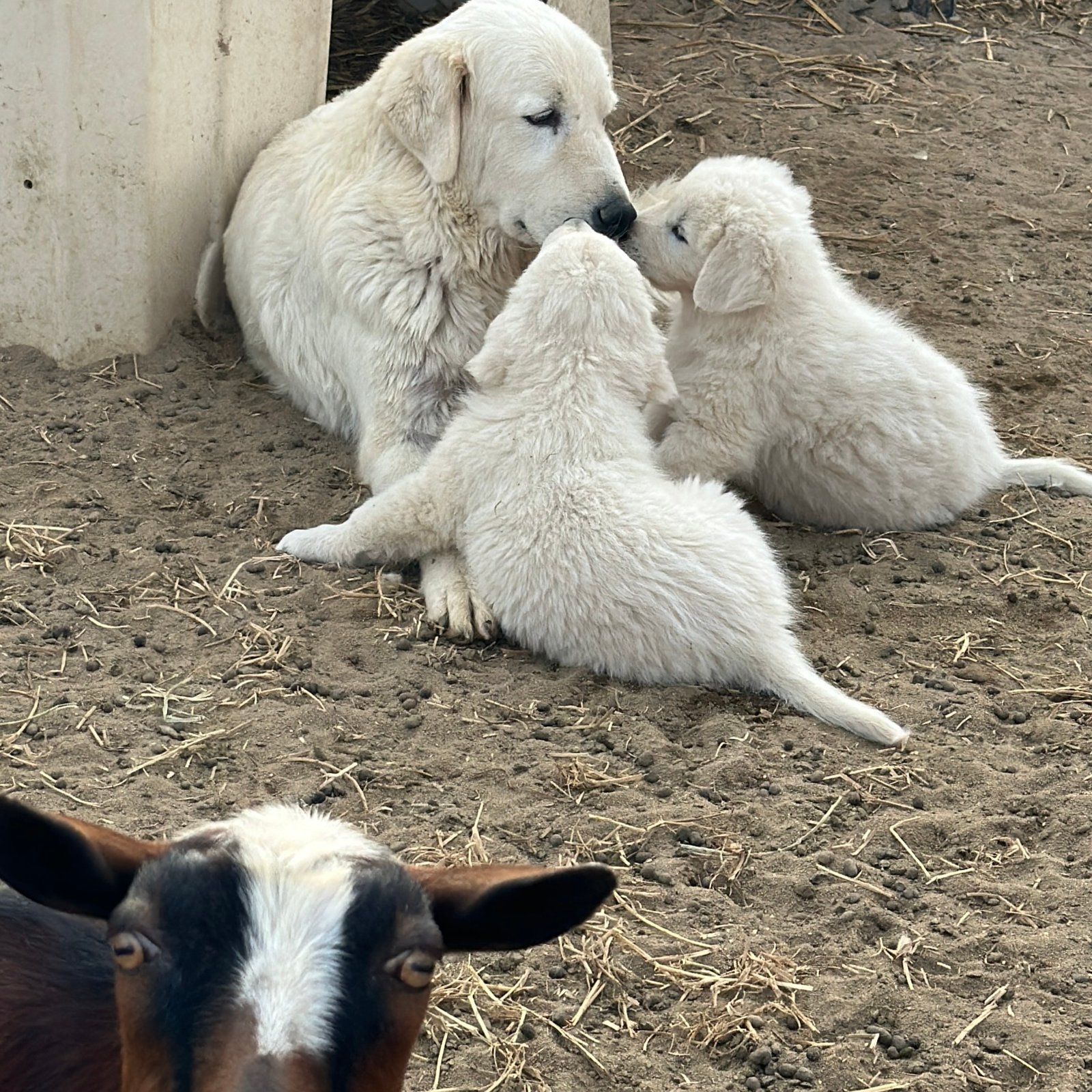
Coming Next Week
In our next installment, we’ll talk about human socialization and how it shapes calm, confident livestock guardian dogs. I’ll show you how my puppies learn to trust people while growing up right alongside the animals they’ll protect.
Ready to reserve your properly socialized livestock guardian dog? Apply for our waiting list – limited spaces available
Want to see how we started with raising our puppies in our barn way back in 2017? Check out “The Perfect Formula for Raising and Training Livestock Guardian Dogs.”

